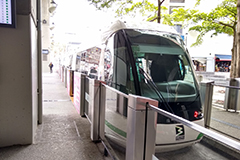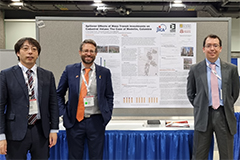Creating a New Future of Transportation and Urban Development: A Dialogue with Research Fellow Suzuki Tomoyoshi
2022.05.16
Drastic urbanization is ongoing in developing countries. Although the development of public transit infrastructure is important in urban planning, its cost is enormous and a huge challenge lies in financing. Suzuki Tomoyoshi, a research fellow at JICA Ogata Sadako Research Institute for Peace and Development (JICA Ogata Research Institute), is searching for the solutions to this challenge. We asked him about his studies on spillover effects of urban transit infrastructure based on surveys in Medellín, Colombia.

—What first made you start to research about transportation in developing countries?
I loved trains, ships, and airplanes from a very young age and which eventually led me to study transportation planning at university. Thinking that my arena of work would be in developing countries if my future career were to be in building large-scale infrastructure like highways, bullet trains or ports, I went to Tanzania during my fourth year at university. This was actually my first trip abroad. In Tanzania the people I met were cheerful, flexible during unexpected situations and laid back in a good way. I felt that this atmosphere was perfect for me. I joined JICA after university and also experienced assignments in Senegal and Tunisia. From 2019, I studied in the UK for a year about Transit-Oriented Development (TOD), which is a series of urban development centered around public transit that develops not only transit infrastructure but also residential areas and commercial areas in its neighboring areas. This made me realize that the problem awareness I had during my ten years or so of practical experience at JICA is strongly related to academic research. That was when an in-house vacancy call for a research fellow position at JICA Ogata Research Institute became available. I applied for this opening and started my current position in 2020.
—Can you tell us about the research you are currently working on?
I am part of a research project on the spillover effects of urban transit infrastructure. This started from a joint application to JICA’s internal call for new project ideas with members of JICA’s Infrastructure Management Department who are in charge of transportation projects. JICA is assisting many developing countries in drawing up a masterplan for urban transportation planning. However, although we recommend the development of public transit infrastructure like mass rapid transit (MRT), light rail transit (LRT) and bus rapid transit (BRT) systems to respond to the urban population growth and further needs for public transit, realization is not easy. This is because the initial investment cost for infrastructure development is large. Even when plans do start moving forward, they can falter midway due to difficulties in securing funding needed to cover operation and maintenance costs. My research looks at ways to secure sustainable financing for transit infrastructure.
When transit infrastructure is developed, housing development starts in areas along its network where there was no development until then. When people start to live there, more shops and offices start to be built. This leads to an increase in real estate prices in nearby areas, and local municipalities can expect an increase in revenue from taxes on fixed assets. However, this tax revenue usually goes into the general accounts of the municipalities and is normally not returned to the transit infrastructure operators. So, we can expect to achieve sustainable financing for transit infrastructure development, operation and maintenance, if we incorporate a scheme that allows for the tax revenue increase to be reinvested in transit infrastructure when developing the masterplan for urban transportation planning, followed by consensus building among stakeholders and necessary system reforms. We call this financing as infrastructure financing that leverages the spillover effects of urban transportation. When it comes to how to return profits due to the spillover effects to the transit service operator, an agreement between the operator and the relevant municipality which states that a certain percentage of the generated tax revenue increase will be used for transit infrastructure could be concluded. Alternatively, it would be possible to issue bonds in anticipation of tax revenue due to the spillover effects from the start. Whatever method is taken, it is going to involve changes in the use of tax income, so necessary decision making and procedures must be completed, such as getting the approval of national and/or local legislatures. A method that matches the local context of each area must be taken. In addition, sufficient time must be allowed for structured discussion to take place, starting prior to transit infrastructure construction.
—As part of your research, what kind of research did you conduct?
To start with, we had to quantitatively study whether transit infrastructure really raised the price of land. We therefore investigated and analyzed how much past infrastructure development affected real estate price in nearby areas in three cities: Medellín, Colombia; Bangkok, Thailand; and Kuala Lumpur, Malaysia. Analyses were successfully made in some areas but struggled in others, where inaccurate data and rejection of data disclosure were bottlenecks. In one case, unlike Japan, an objective system for real estate appraisal was not established and appropriate figures could not be collected. In another case, data could not be disclosed per area because of political reasons. There also was a case where fine-scale geographical data was not available and we struggled with the analysis.
Nevertheless, analyses successfully progressed in Medellín. Several reasons were behind this including the following: relatively detailed data on official land price (cadaster value) was available; Metro de Medellín, the company that comprehensively operates cable cars that connect the Medellín city center and peripheral hilly areas, urban railway services, and LRT lines, was seeking for additional income sources in addition to fares and had high expectations in our research project; and Metro de Medellín and the city authorities were in a partnership. What is more, the cooperation from Erik Vergel-Tovar, an assistant professor at the Department of Architecture at Universidad de los Andes in Bogotá (Colombia) who is well known for his academic work on transportation and urban development field, was significant. Erik is a former administrative agency officer who studied in Japan about land readjustment as a JICA trainee in the past, and with his wish to give back to Japan, he kindly guides our research team. Great contribution came from Julian Muñoz, a local staff at JICA Colombia Office as well. When there are data that you would like to obtain in developing countries, even if you visit a municipal office and make a request at the service desk, these will not be provided to you shortly. Julian patiently approached relevant authorities to establish good relations with them and got the data over a year. Analysis confirmed land price increases in areas near the developed public transit. It also showed that the different level of increase between means of transit like railway and cable car. Furthermore, since public transit is a network of systems, we were able to confirm that land price increase in areas near the service routes took place at the same timing as the overall transportation network expansion that followed the connection between different means of public transit. The success in Medellín was achieved because there was synergy between each person’s strength, allowing for great collaboration.

Light Rail Station in Medellín, Colombia
—How are you going to make the use of the results?
In January 2022, Erik, Julian and myself presented our research results at one of the world’s largest conferences on transportation, the Transportation Research Board (TRB) Annual Meeting 2022, held in Washington D.C. There being not that many studies on transportation in developing countries and with the research topic being relevant to all developing countries, we received a lot of response from the participants. For example, we were asked how we are going to incorporate the discussion on infrastructure financing that leverages spillover effects into masterplans on the ground.

Research Fellow Suzuki Tomoyoshi (far left) at the Transportation Research Board Annual Meeting 2022
Through the surveys, we learned how real estate price is an intricate subject. When you live in a developed country, you tend to think it is natural for revenue from taxes on fixed assets to increase when land price rises following transit infrastructure development. In developing countries, however, appropriate property valuation standards may not be in place, or to begin with, there may not be any systems based on property price. In Tanzania, for example, property tax rates are decided based on the type and size of the building (although I have been told that they are going through a system reform right now). Let me give you a slightly simplified example. If this was the case in Japan, it would mean that the tax imposed on a three-story building would be the same amount whether it is built in the big city of Tokyo or rural area of Hokkaido. Things will not be enough when we only apply Japanese common sense and typical perspectives. We need to step back from these and fully acknowledge the diversity of systems around land price and taxes on fixed assets. In some countries, it may be necessary for us to start by providing assistance for appropriate asset valuation rather than jumping into the spillover effect discussion. There is so much we can gain from failure. I would like to first try, accumulate knowledge and experience, and study further.
On another note, based on our study, we made a standard workflow to consider infrastructure financing, which covers spillover effect to masterplan preparation. We have published this workflow in a field report, which is one of the publications of JICA Ogata research institute. In addition, we made a video that explains what spillover effects are. We would like to show this to decision makers in developing countries and actively promote the importance of considering the introduction of infrastructure financing from the early stages of their masterplans.
—What are your future aspirations?
We are going to start a new research project, namely the empirical research on the social and economic impacts of infrastructure projects. To date, the effects of transit infrastructure are usually evaluated from macro perspectives, measuring for example, how much the economic effects amount to in total. However, from now on, evaluation from micro perspectives like inclusiveness, environmental sustainability and safety will be required in the field of transportation as well. For example, we would need to see whether the benefits of transit infrastructure are equally distributed to a diverse range of people living in urban areas, with no disparities and in a well-balanced manner. We are planning to conduct a survey on approximately 4,000 households living near the MRT line currently under construction with assistance from JICA, in Dhaka, the capital of Bangladesh. We will look at changes in household economic situations and commuting time with some perspectives in inclusiveness and gender issues. On another note, new types of data that were not available until recently are becoming available. I am planning to quantitatively study the impacts urban public transit had on real estate prices by collecting data on the following: real estate prices in areas near the urban railway system under construction in Ho Chi Minh City, Vietnam; and rents for apartments and offices along the MRT line that opened in Jakarta, Indonesia, in 2019.
The 20th century was the era of automobiles but now is the century of public transit. Moreover, developing countries will enter the era of urbanization. In particular, Africa has the highest population growth rate in the world and the population inflow to urban areas will increasingly grow. Public transit is crucial for urban infrastructure development, even in terms of environment, traffic safety and energy efficiency. The current mainstream of African urban transportation is informal non-mass transit like private minibuses (often called paratransit), and road congestions and poor accessibility are significant challenges. Some African cities will enter a phase in which public transit systems—mainly BRT systems—will be developed one after another, but not all challenges are going to be solved by simply introducing these. We must always consider the relationship between transportation and urban development from an integrated perspective; for example, designing possible compact cities with urban functions centralized along public transit networks as much as possible and avoiding urban sprawls. “Transportation and urban development” is my life work. By integrating practice and academic research, I would like to continue pursuing this theme.
Spillover Effects on Urban Transformation

事業事前評価表(地球規模課題対応国際科学技術協力(SATREPS)).国際協力機構 地球環境部 . 防災第一チーム. 1.案件名.国 名: フィリピン共和国.

事業事前評価表(地球規模課題対応国際科学技術協力(SATREPS)).国際協力機構 地球環境部 . 防災第一チーム. 1.案件名.国 名: フィリピン共和国.

事業事前評価表(地球規模課題対応国際科学技術協力(SATREPS)).国際協力機構 地球環境部 . 防災第一チーム. 1.案件名.国 名: フィリピン共和国.

事業事前評価表(地球規模課題対応国際科学技術協力(SATREPS)).国際協力機構 地球環境部 . 防災第一チーム. 1.案件名.国 名: フィリピン共和国.

事業事前評価表(地球規模課題対応国際科学技術協力(SATREPS)).国際協力機構 地球環境部 . 防災第一チーム. 1.案件名.国 名: フィリピン共和国.
scroll